The Shansei Type 17
.45 Auto Broomhandle Pistol
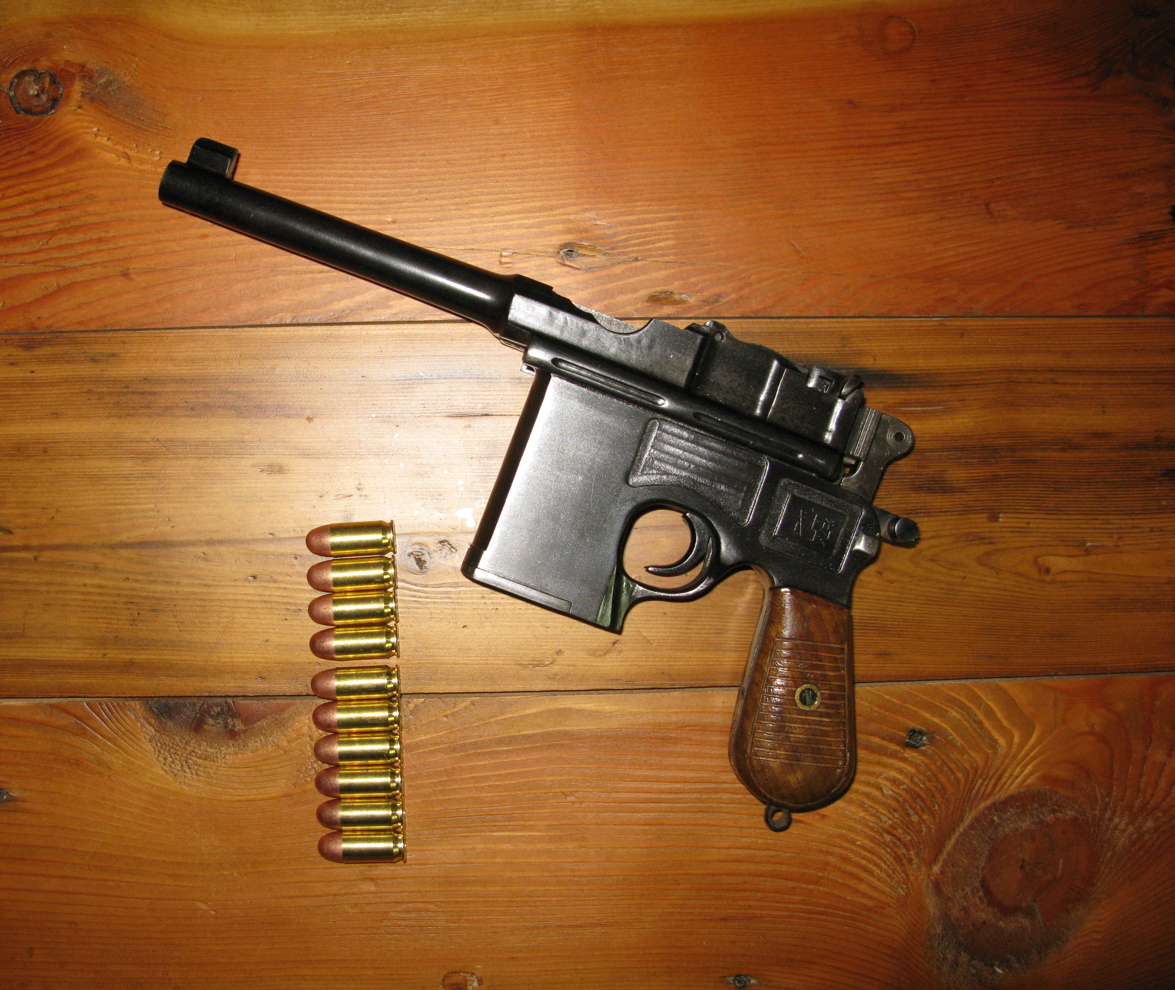
The Shansei Type 17 |
The Holy GrailIn 1983, a friend introduced me to a fictional character that appealed to all my ideas of adventure at the time. A former Rhodesian game ranger turned mercenary, Jon Sable was, in character, an amalgamation of James Bond, Tarzan, Sam Spade, Allan Quatermain and "Mad Mike" Hoare. Created, drawn and written by Mike Grell, the independent First Comics series Jon Sable, Freelance, struck a chord with me as a young man in those days when the last remnants of the colonial era were fast fading from the undeveloped world, communist-terrorist insurgents were a constant menace and old-school approaches to dealing with villains were somewhat more politically-correct. Jon Sable's signature weapon was as original and singular as his character, a big .45 caliber Mauser Broomhandle manufactured in China during the Nationalist Warlord Period preceding World War II... 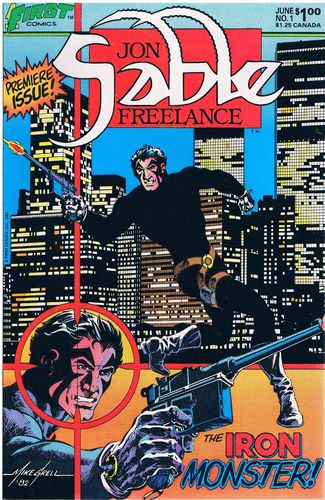
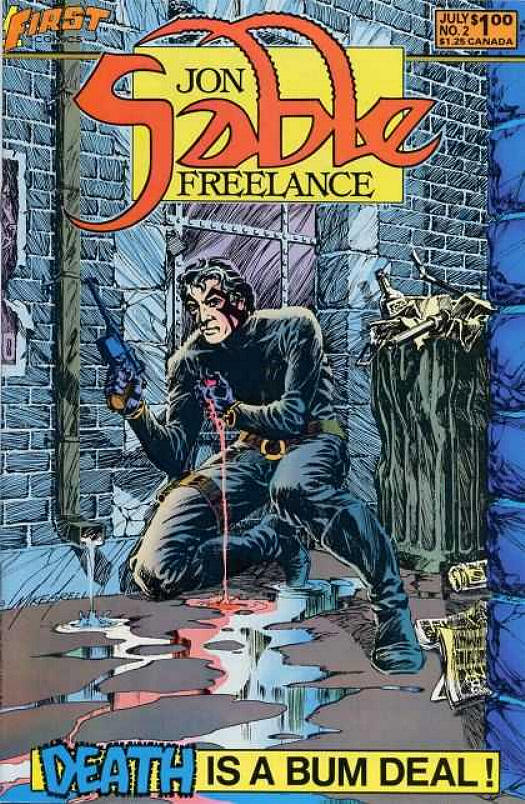

Early covers in Mike Grell's Jon Sable, Freelance series by First ComicsI had always been a tremendous fan of the Mauser Broomhandle, and the thought of one of these pistols made in .45 caliber staggered my imagination. Nothing could be more awesome. For many a year I sought one of these legendary pistols. I actually held one briefly in St Louis in 2005, but deemed it too pricey at the time and thought that it looked a bit roughly made. Later, seeing how internet auctions priced better finished examples in good condition, I decided that I would never be able to afford one. This was for me the Holy Grail of collectible pistols, on a par with a long-barreled Luger or a mint condition Smith & Wesson New Model No. 3 in .44 Russian. Well, sometimes the impossible comes true. Thirty years after I first discovered the big Chinese .45 Broomhandle, I came into possession of a fine example in near pristine condition that I could afford. I say legendary advisedly because, if the conventional wisdom is correct, there are only around 350 of these extant in the US, with probably a smaller number surviving in Europe. That is even less than the original production run of the Colt Walker. They are undeniably scarce, even though a few examples are found on various gun auctions and internet sales sites as I write these words. Prices typically range from $2500 to $5000. A decade ago the going rate was around $1000 to $1250. Moreover, facts in the case of these pistols are slippery. Not much is known with any certainty, at least in the broad public. So, I am attempting a serious effort at establishing the truth. Much of the information that I was able to uncover on the internet can be traced back to an article that was written by David M. Fortier for Gun World in February 2001, entitled Giant .45 'Broomhandle' from China. Fortier has become, alongside Peter G. Kokalis and Garry James, one of the foremost experts on military firearms of the past and present. Many online sources describing the Shansei Broomhandle repeat Fortier, sometimes verbatim and without attribution. Another reputable source is a book on the subject of all the Broomhandle variants entitled, The Broomhandle Pistol 1896 - 1936 by Wayne R. Erickson and Charles E. Pate; a highly sought out of print study published in 1985. As far as online references, further details of the pistol's history come from individuals whose knowledge must, for now, be taken at face value. Thus far, I have not found an older reference than the 1980s with the exception of System Mauser by John W. Breathed Jr and Joseph J. Schroeder, Jr., which was first published in 1967 and devotes several pages to the Shanxi Broomhandle. Unfortunately, I have been unable to obtain this particular source. What is definitely known is this: During the late 1920s, in the period of the Chinese Republic after the 1911 Xinhai (Hsin-Hai) Revolution that ended the Qing dynasty, Marshal Yan Xishan (or Yen Hsi-Shan), the Governor-General of the province of Shanxi (Shansi or Shansei), became dissatisfied with the weapons issued to his troops, in particular those of the railway guards that defended his trains from attacks by bandits. He was very fond of the .45 caliber Model 1921 Thompson submachineguns that he had issued them, and, like most Chinese military men, warlords, bandits and pirates, he was exceedingly approving of the Mauser C96 type pistols they carried. Trouble was, the pistols used different ammunition, which was both inconvenient to the troops and a logistics burden. Describing Yan Xishan as a "warlord", as is typical in biographic sketches, conjures an image of a portly barbarian attired in yak hides with a broadsword and a brace of pistols in his belt. In reality, Yan Xishan was a well educated and by all accounts highly capable public administrator, who strove to technologically modernize Shanxi province while preserving traditional Chinese culture. He was also a great proponent of military preparedness and his forces were among the last holdouts against the Communists in the late 1940s. 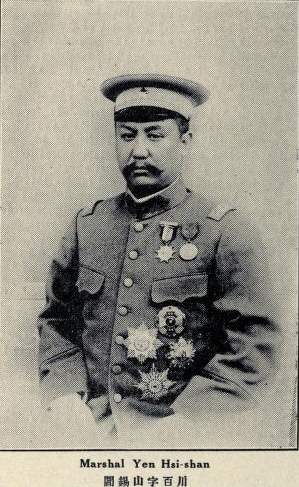
Marshal Yan Xishan in the 1920sIn the Shanxi capitol of Taiyuan, Governor-General Yan Xishan commissioned the engineers of his arsenal, the Shanxi Military Technology Practice Factory, to design a .45 Automatic Colt caliber version of the Mauser C96 Broomhandle pistol. The Taiyuan Arsenal was very advanced, being staffed with foreign technicians and US-trained Chinese engineers. The arsenal was allegedly the only Chinese arms manufacturer capable of producing field artillery, which they manufactured in several forms, including the German high-velocity 88 mm. By the mid-1920s, the Taiyuan Arsenal was producing rifles, Thompson submachineguns, Mauser C96 Broomhandle pistols and all their ammunitions, in addition to other ordnance. They succeeded and beginning in 1929, the Taiyuan Arsenal produced the new Type 17 pistol. Most sources cite a total production number of about 8500 between 1929 and 1931. In all respects the Type 17 is a true copy of the Mauser C96, except that it is proportionately larger. Apart from the magazine, which extends slightly below the trigger guard, it is indistinguishable from a German-manufactured Mauser at any distance or when nothing is present to provide a sense of scale. Though larger, it is far from unwieldy and, to my mind, it is the most properly sized of all the C96 models (though that may be my American bias for large caliber pistols). No one made 10-round stripper clips for these, instead they used 5-round stripper clips and I strongly suspect that these were those also used by the Hanyang Type 88, a Chinese manufactured copy of the Gewehr 1888 Commission Rifle, since the 8 x 57 mm Mauser and the .45 ACP have the same rim diameter. According to the article by Fortier, who enlisted the aid of a Chinese linguist to translate the markings stamped on the frame of the pistol, on the left side the inscription allegedly reads: "Type 17", although at least one online source asserts that it reads "First Type" or "Type 1" and another that these pistols are "Type 11". I do not read any form of Chinese script and Chinese in all its variations is an extremely difficult language, probably the most obtuse on Earth. I could verify that one of the characters (leftmost), "shi", means "type", as in model, form, style or pattern. Another character looks to my untrained eye like a backward Chinese seven. I tried some online translators with little success. None of the online translator's suggestions for "seventeen", "one" or "first" resembled the remaining characters on the left side of the frame. The final character resembles the ideogram for "bow", which in Chinese can be a generic term for a weapon. I tried "pistol" but that did not seem to match. 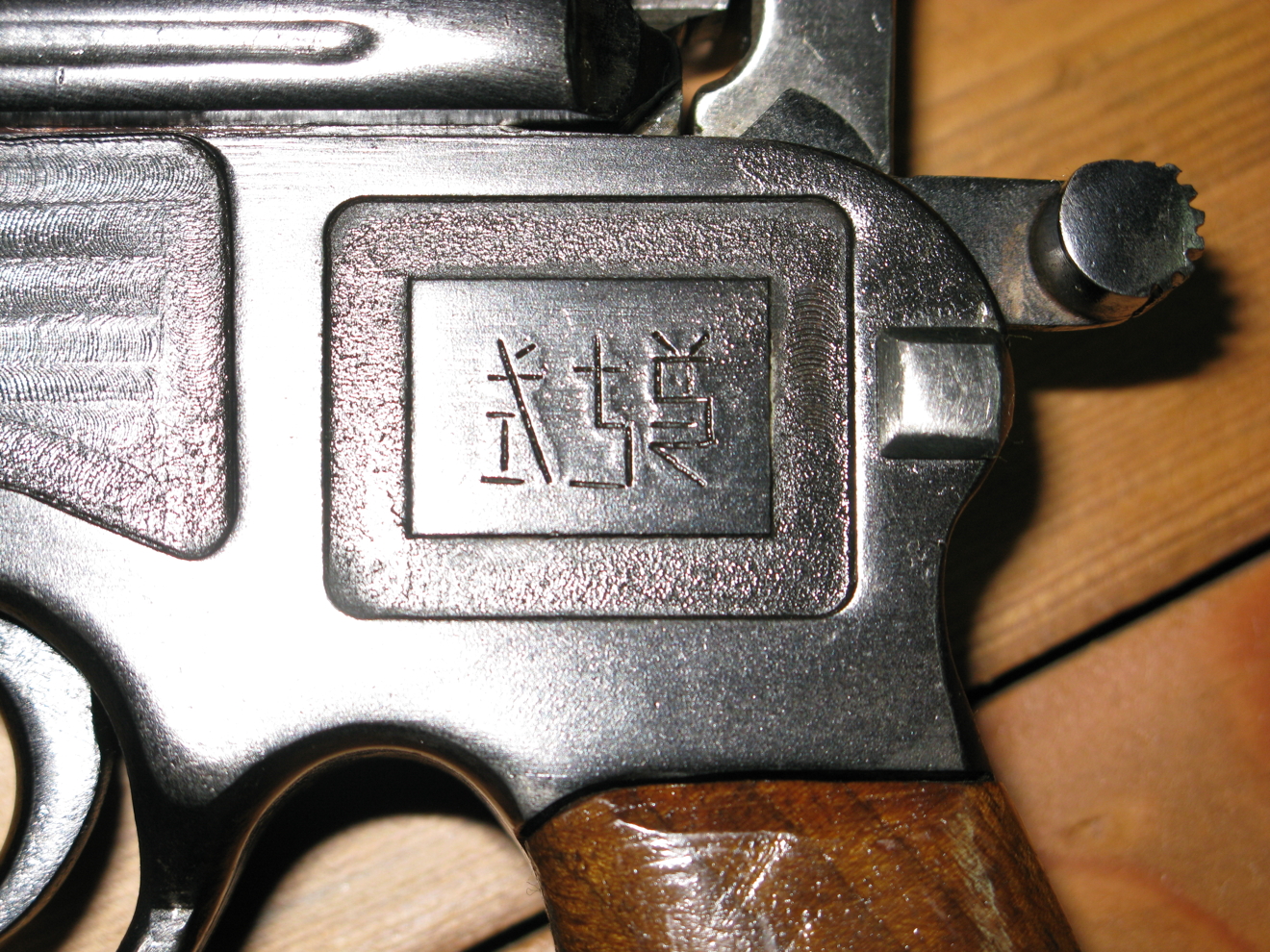
Inscription on the left side of the frame: "Type 17"Again according to Fortier, the right side inscription reads: "Nationalist Year Eighteen [Nineteen or Twenty] Made in Shanxi". Alternatively, according to other sources, it reads "Republic Year...". The year corresponds to the number of years since the 1911 Xinhai Revolution, so Year 18 would be 1929. My best effort at finding a translation reads "Guo Min [National] Shi Ba [Eighteen] [?] [Fabricate(d)] Shanxi". 
Inscription on the right side of the frame: "Republic Year 18, Made in Shanxi"According to Fortier and other sources, almost all of these pistols were collected by the Communists after they assumed power in 1949 and stored because they used non-regulation ammunition. Years later, legend has it, they were melted for scrap. How a small number of pistols in generally excellent condition escaped this lamentable fate and remained undiscovered for decades is not known. What may be inferred is that, upon discovery, someone seized on the opportunity to sell them to the foreign collector market. Between 1985 and 1990, TTN International of Taiwan exported the few surviving Type 17 pistols to the US and Europe. Three importers in the US distributed the pistols: Navy Arms of Ridgefield, NJ, IAR, Inc. of San Juan Capistrano, CA and the Bricklee Trading Company of El Monte, CA. It is believed that only 350 of these pistols were imported, although I do not know the basis for that figure. It is also widely believed that these recently imported pistols were newly produced by the People's Republic of China for the American market, however this theory doesn't stand up. For one thing, no one would produce so few numbers if they were trying to introduce a new product. Secondly, the cost of production on the Mauser Broomhandle design is one of the reasons why it eventually disappeared despite its great popularity and global success, including unlicensed copies in several countries. It is incredible to contend that any of these pistols is other than an original Type 17 from 1929 to 1931. My personal Type 17 was imported by the Bricklee Trading Company, the successor company to Federal Ordnance. Bricklee is out of business now, so there is no way to discover anything about the circumstances of my pistol's importation. It is in remarkable condition, with near pristine rust blueing over the metal. The bore is perfect. The finish is not to early-20th century Old World standards, but not rough or crude and better than on many current production American firearms. There are some machining marks on the barrel-slide assembly and from the engine turning on the cartouches of the frame and the polish has a bead blast appearance. The only corrosion is a small spot of rust on the right side of the hammer (it can be seen in the photo above). 
Shansei Type 17 "Broomhandle" pistol - left profile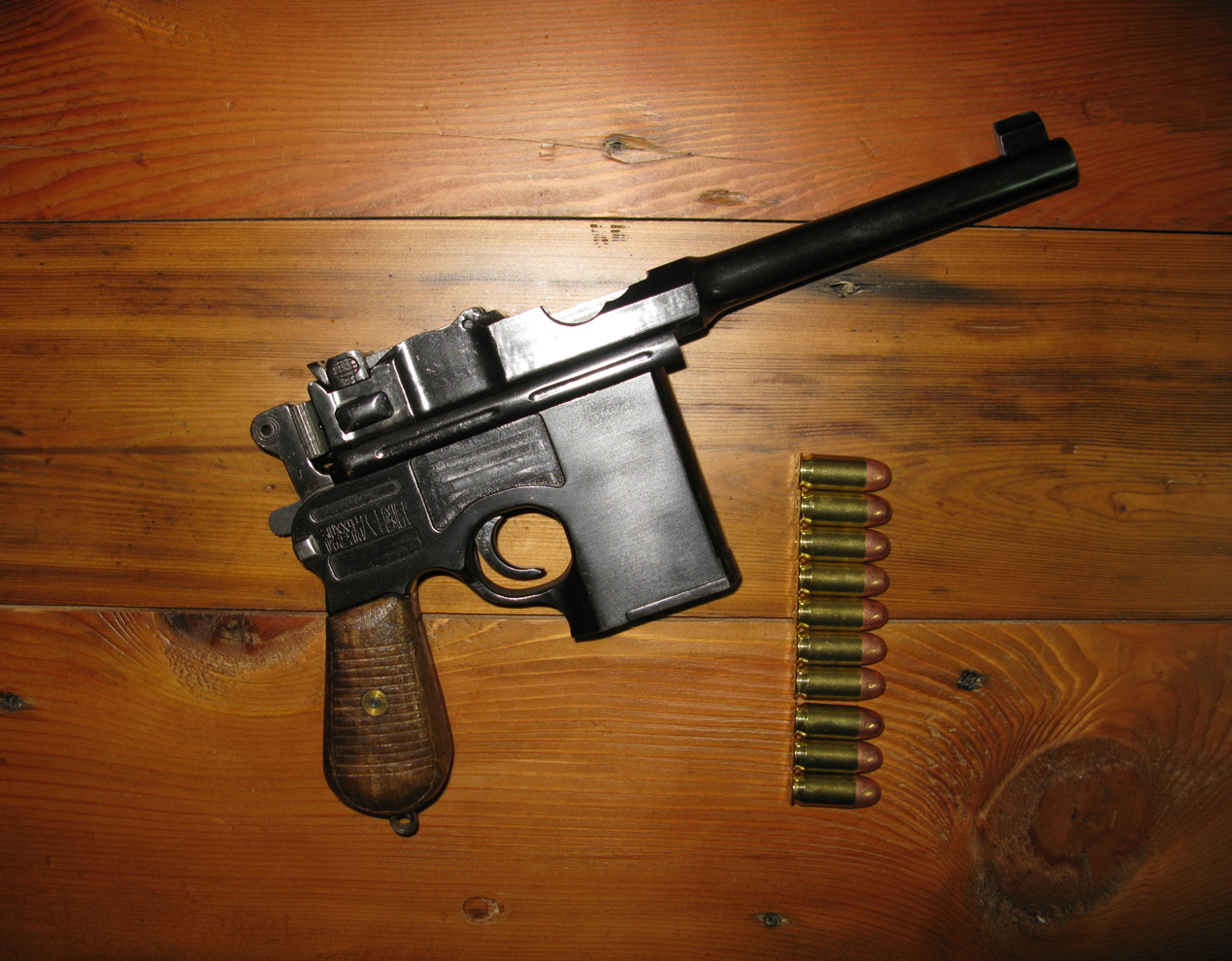
Shansei Type 17 "Broomhandle" pistol - right profileShooting the ShanseiThis pistol was manufactured during the era of the original ballistics of the .45 Automatic Colt Pistol, which propelled its 230 grain roundnosed bullet to a respectable 800-something fps. Modern ammunition often significantly exceeds the old pressure standard. So, the trick is to find ammunition that still has a muzzle velocity in the mid-800s. That will be safe. The +P stuff probably is not and why take a chance on a rare vintage pistol? With that thought in mind I got hold of some Speer CCI Blazer Brass ammunition with an advertised velocity of 830 fps. Blazer ammunition is sometimes a bit mild and although this is brass-cased rather than aluminum-cased, it was a touch under the typical load level. Accuracy was truly abysmal. Bullets struck the target all over the place, even at close range. The trigger is awful; it is creepy and breaks like a rotten banana. However, I don't think that the trigger was the cause of the poor accuracy. Considering the excellent condition of the bore, I suspected that the cause was poor bullet fit. I pulled one of the bullets and measured it. It read between .4505 and .4510 inches, which is slightly under the nominal .451 diameter for the .45 pistol caliber. Its a small difference and should not be sufficient, but possibly the bore in the Shansei Broomhandle is larger than .451 caliber. These are the Speer Total Metal Jacket (TMJ) electroplated bullets. The jacket is very thin and deforms easily, but I think it prevents the bullet from bumping up in diameter as might would occur with a soft lead bullet. Of course, a soft lead bullet would probably jam in an automatic. This old pistol has a bad tendency for misfeeding as it is. With this discovery in mind, I went in search of an alternative loading to test fire. The last thing that I wanted to do was handload any cartridge that was to be fired in an automatic. My time is more valuable than the cost of commercially available ammunition. I prefer to devote my painstaking handloading effort to rifles, especially obsolete rifles. However, if need be I recognized that it might be necessary to obtain some hard cast bullets of a larger than normal diameter in order to improve the accuracy. Sure enough, a box of standard Winchester 230 grain FMJ target loads delivered a meaningful improvement in accuracy. Still nothing to brag about, but promising. I intend to continue the search for the perfect load, but for the present the Winchester white box suffices. Lately, ammunition scarcity has made it difficult to try a variety of loads. Until the day that I discover a load that hits the magic combination of propellant, charge weight and bullet diameter for accuracy, I will suspend judgment. Thus far, however, the performance of this legendary pistol doesn't quite live up to its mythic mystique. Return to: Classic Rifles, Pistols and CartridgesCopyright 2013 - 2023 -- All Rights Reserved |